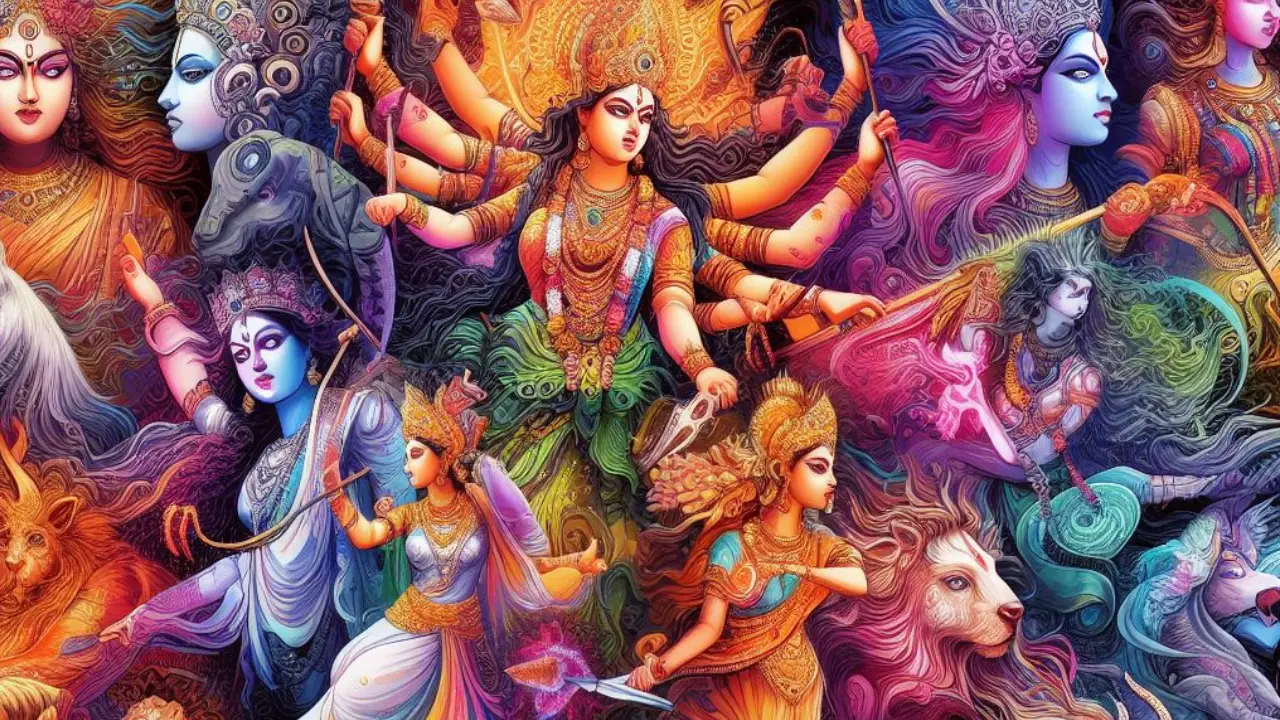Goddess Shakti, also known as Devi, is one of the most revered and worshipped deities in Hinduism. She is the divine feminine energy that represents the creative power of the universe. Shakti is believed to be the source of all life and is the embodiment of strength, power, and vitality. The term ‘Shakti’ means ‘power’ or ‘energy’, and as a deity, she has many forms that represent different aspects of her multifaceted nature.
In this blog post, we will explore the different forms of Goddess Shakti and their significance in Hindu mythology.
Durga: The Invincible Goddess Shakti
Durga is one of the most popular forms of Shakti. She earns the title of the invincible goddess who rides a lion or tiger, holding weapons in her many arms. Durga frequently portrays herself with eight or ten arms, each gripping a weapon to defeat evil forces and safeguard her devotees. People also recognize her as the mother of the universe and venerate her during the nine-day festival of Navratri.
Kali: The Fierce Warrior
Goddess Kali is another powerful form of Shakti, often associated with destruction and chaos. Kali, a fierce warrior goddess with a dark complexion, long hair, and a necklace made of skulls, portrays herself. Her tongue sticks out, symbolizing her thirst for blood and her power to conquer evil. People worship her during the festival of Kali Puja, which occurs during the new moon in October or November.
Parvati: The Goddess of Love and Devotion
Parvati is the wife of Lord Shiva and represents the aspects of love, fertility, and devotion.
Often portrayed as a beautiful goddess with a serene expression, Parvati holds a lotus flower or a mirror. She is also recognized as the mother of Ganesha, the elephant-headed god of wisdom and good fortune.
Saraswati: The Goddess of Wisdom and Knowledge
She is the goddess of wisdom, knowledge, and learning. Saraswati often depicts herself playing the veena, a musical instrument, and holding a book and a pen. She is also associated with the power of speech, and people believe that she can inspire creativity and enhance intelligence.
Lakshmi: The Goddess of Wealth and Prosperity
Lakshmi is the goddess of wealth, prosperity, and good fortune. She is often depicted with four arms, holding a lotus flower, gold coins, and a pot of wealth. Lakshmi is worshipped during the festival of Diwali, which is celebrated in October or November.
Radha: The Goddess of Love and Devotion
People revere Radha as the embodiment of love and devotion, and she is the consort of Lord Krishna. Artists often depict her as a beautiful goddess with a peacock feather in her hair, holding a lotus flower or a flute. During the festival of Holi, devotees worship Radha to celebrate the love between her and Krishna.
Chamunda: The Destroyer of Evil
Chamunda embodies a fierce form of Shakti and people worship her as the destroyer of evil forces. She often appears depicted with a garland of skulls around her neck while holding a trident, sword, and bowl of blood. People also know her as Chandi, and they worship her during the festival of Durga Puja.
Tripura Sundari: The Beauty of the Three Worlds
The devotees worship Tripura Sundari as the embodiment of divine feminine grace and elegance, considering her the goddess of beauty. She possesses four arms, holding a lotus flower, a book, and a rosary in her hands. The three worlds revere her as the supreme beauty, and it is believed that she brings harmony and balance to the universe.
Bhuvaneshwari: The Queen of the Universe
Bhuvaneshwari is the goddess who rules over the entire universe. She often sits on a lotus flower, symbolizing her purity and transcendence over worldly desires. People believe that Bhuvaneshwari possesses infinite power and wisdom, and her devotees seek her blessings for guidance and protection.
Gauri: The Radiant Goddess Shakti
Gauri is another form of Shakti who represents purity and radiance. She often appears fair-skinned, with a gentle and benevolent appearance. Married women worship Gauri for marital bliss and a harmonious family life. During festivals like Vat Savitri and Hartalika Teej, married women fast and pray to Gauri for the well-being and longevity of their husbands.
Mahakali: The Great Dark Goddess Shakti
Goddess Mahakali is a powerful and fierce aspect of Shakti, representing the primordial energy of creation, preservation, and destruction. Mahakali often depicts herself with a terrifying appearance, wearing a garland of heads or skulls and carrying weapons in her hands. People worship Mahakali to seek protection and liberation from negative influences and to overcome fear and ignorance.
Maha Lakshmi: The Great Goddess of Wealth
Maha Lakshmi is an embodiment of Lakshmi in her most expansive and majestic form. As the goddess of wealth and prosperity, people worship her to attain financial abundance, success, and good fortune. They depict Maha Lakshmi with numerous arms, each holding symbols of prosperity, and often accompany her with elephants, which symbolize royal power and abundance.
Rajarajeshwari: The Sovereign Queen Shakti
Rajarajeshwari is the queenly form of Shakti, radiating grace, elegance, and regal authority. Goddess Shakti holds the revered position as the supreme ruler of all beings, and her devotees seek her blessings for leadership qualities, spiritual guidance, and overall well-being.
In Hindu mythology, people worship numerous forms of Goddess Shakti. Each form represents a different aspect of divine feminine energy, and devotees revere them to seek blessings, protection, and spiritual growth. In Hindu culture, people hold the worship of Goddess Shakti in significant regard because they consider her the motherly source of all creation and the nurturing force that sustains the universe.

